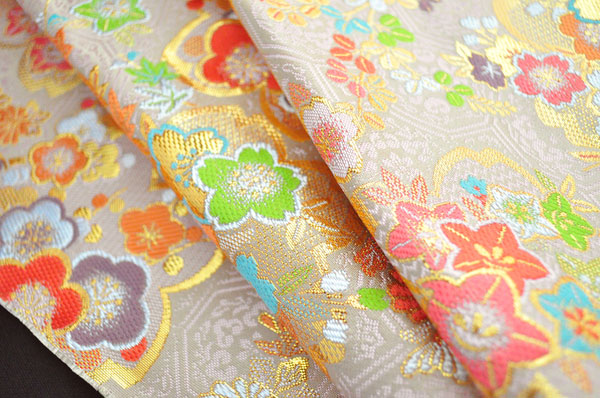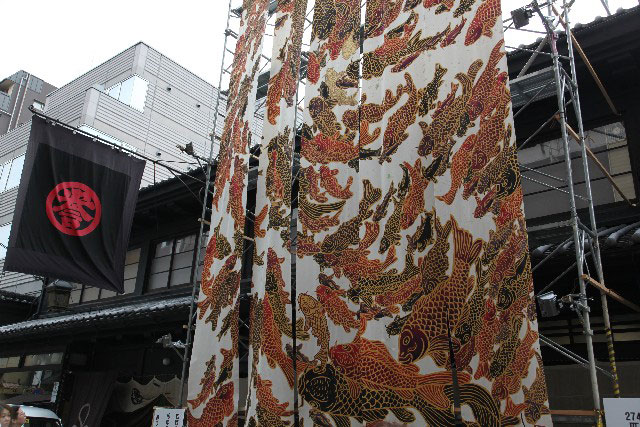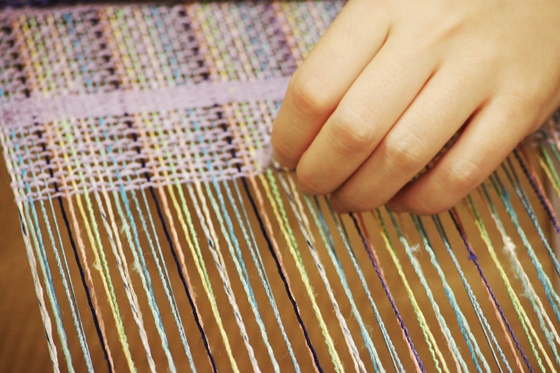
- Woven textiles
- Kyoto
Nishijin brocade Nishijin ori
Luxurious high quality silk fabric
with more than a thousand-year history in the court of Kyoto
Description
What is Nishijin brocade ?
Nishijin brocade (called Nishijin ori in Japanese) is woven silk produced in the northwestern part of Kyoto. Kamigyo ward and Kita ward cover this area of Kyoto today, but this area is called Nishijin. According to official rules, only the brocades that are produced at fabric makers (called oriya) in Nishijin can be described as Nishijin brocade. The production process varies slightly depending on the fabric makers but there are currently twelve kinds of Nishijin brocade designated by the regulations. Initial production of Nishijin brocade began all the way back during the Kofun period (250-538AD). However the fabric was only named Nishijin ori during the 15th century after a major civil war, Onin War, (1467-1477) which had much of its fighting based in Kyoto, ended. With the war over, textile craftsmen who had fled the area were able to go back to Nishijin and resume production of Nishijin brocade. Therefore, the fabric was named Nishijin ori, which means western military encampment brocade, after the area where it had revived its production. Since it is woven after the threads are dyed, the fabric is tougher and more wrinkle resistant than fabrics that are woven before being dyed. Some of the main varieties of Nishijin brocade are tsumugi (fabric woven with thin silk threads), Honshibo-ori (fabric with textured crepe weaving), and futsu (double sided fabric with different colors and patterns on each side). A notable feature of Nishijin brocade is that watermark fabrics such as sha (a thin silk fabric) and ra (a roughly woven silk fabric) are used. The designs have a wide range, from simple to chic. Nishijin and Nishijin ori are registered trademarks in order to preserve the traditional process.
History

The birth of Nishijin brocade goes back to the 5th or 6th century when migrants from the neighboring countries of Korea and China brought silk farming and fabric to Kyoto. Silk weaving of expensive silk fabrics became an official occupation in the Heian period (784-1185). Oribe-cho, a town where the craftsmen gathered to produce silk fabrics, was settled. The town was in an area that is now known as Kamigyo ward in northwestern Kyoto.
When the official silk fabric production business declined, the craftsmen started their own workshops for silk fabric production in an area near Oribe-cho. The silk and the twill fabrics produced by these craftsmen were esteemed for their high quality. During the Muromachi period (1336-1573), the establishment of an organization for fabric makers called Otoneri za increased the amount of silk fabric orders even more.
Furthermore, the Jacquard loom, a loom that uses a chain of punch cards to instruct it on how to automatically make complex designs, was introduced from Europe during the Meiji period (1868-1912). The Jacquard loom made it possible for textile craftsmen to attain a higher level of weaving technique because of the automated patterning. Textile craftsmen are enthusiastically producing various new products that match the modern lifestyle, such as western style kimono and interior items, as well as traditional kimono.
General Production Process

- 1. Designing
Nishijin brocade uses threads dyed in advance instead of dying them after being woven. This means that the designer has to plan the design by imagining the finished fabric. When an order comes from a manufacturer, the designer starts designing by combining the traditional design with the preferred design.
- 2. Design mapping
The next step is to draw a design. This design map is referred to as mon ishozu.
Mawashi and hatsuri are done during this process. Mawashi is copying the design using pencils on a grid sheet-like paper by projecting the enlarged design and hatsuri means painting the drawing in accordance with the grids on the paper.
The grids show the combination of the warp threads and the weft threads (the two basic components of thread). As well as colors and threads, this paper also contains various instructions and information to make weaving easier.
- 3. Pattern paper punching The goal of this step is to enable the loom to take the information from the design map and weave the fabric within the planned design. This process is to punch holes on the pattern paper called monshi. This specifies information including the positions for the warp and the weft threads to go up and down and the combinations of the colored threads in each grid. The holes are made precisely using a machine called a piano machine. Recently, computer graphics are also widely used.
- 4. Twisting the threads
This is the first step to prepare the threads for Nishijin brocade.
Multiple threads are twisted together and the thickness is adjusted.
The distinctive texture of Nishijin brocade is created by twisting threads of varying thickness.
- 5. Dying threads
The next step is to refine the threads in order to keep them white by removing the animal protein that would leave a yellow tint on the fabric.
After the refinement, the threads are dyed in the decided order of colors. Dying the threads is an important process that determines the texture of the finished fabric.
- 6. Reeling the threads
The warp threads and the weft threads are wound onto a reel to ease the weaving.
This process used to be done manually but it is mainly operated with machines today.
- 7. Warping and weft winding The warp threads and the weft threads are set on the loom. Thousands of warp threads are required for weaving and they have to be sorted into a precise number and length. This process is referred to as warping. In the meantime, the weft threads are wound onto the bamboo tubes that are set in the shuttle. This process is referred to as weft winding.
- 8. Heddle
The warp threads are put through the heddle, a looped cord which separates and divides the warp threads, of the Jacquard loom.
This is an important process to produce the complicated patterns of Nishijin brocade.
- 9. Hand looming
Handlooms, Jacquard looms, power looms, and manually operated weaving machines are used to weave the fabric.
Power looms have become more widely used because they are capable of producing complex designs. However, manually operated handlooms are still necessary for delicate weaving that includes gold brocade.
Where to Buy & More Information
Nishijinori Kaikan
-
Address
-
Tel.+81-75-451-9231
-
ClosedDecember 29 to January 3
-
Business Hours10am to 4pm
-
Website
Kyoto Museum of Crafts and Design

-
Address
-
Tel.+81-75-762-2670
-
ClosedDecember 29 to January 3
-
Business Hours9am to 5pm
-
Website
See more Woven textiles
- Nishijin brocade
- Yuki tsumugi silk
- Kurume traditional resist-dyed textiles
- Ojiya chijimi textiles
- Hakata brocade
- Ushikubi tsumugi silk
- Chichibu-meisen silk
- Miyako ramie textile
- Shiozawa tsumugi silk
- Kumejima tsumugi silk
- Omi ramie cloth
- Ryukyu traditional resist-dyed textiles
- Kiryu brocade
- Murayama-oshima tsumugi silk
- Yumihama traditional resist-dyed textiles
- Chibana-hanaori textiles
- Hon-shiozawa silk
- Oitama tsumugi silk
- Ojiya tsumugi silk
- Yaeyama cotton cloth
- Yaeyama ramie cloth
- Honba oshima tsumugi silk
- Shinshu tsumugi silk
- Shuri brocade
- Tama brocade
- Yomitanzan-hanaori textiles
- Isesaki traditional resist-dyed textiles
- Hachio island silk
- Nibutani bark cloth
- Uetsu tilia bark cloth
- Awa-shijira cotton cloth
- Kijoka banana fiber cloth
- Tokamachi traditional resist-dyed textiles
- Tokamachi akashi chijimi textiles
- Yonaguni brocade
- Yuntanza minsa
- Flower pattern textiles
- Oku-Aizu Showa Karamushi Textiles































































































































































































































































































